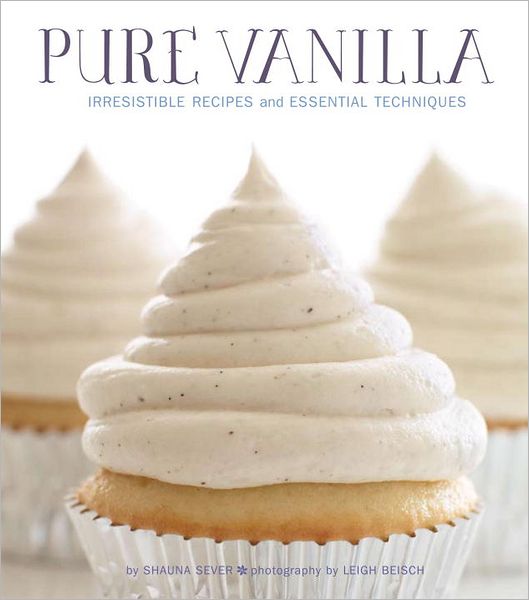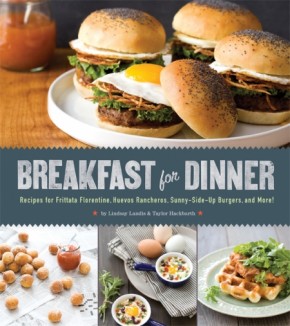Pure Vanilla Irresistible Recipes and Essential Techniques
Poor Vanilla—her sexy sister Chocolate gets all the attention!…But that is about to change.
Poor Vanilla—her sexy sister Chocolate gets all the attention! But now Quirk is giving this unappreciated spice the complete makeover it deserves. Pure Vanilla is a gorgeous cookbook celebrating the world’s most heavenly and ambrosial flavor.
Chapters cover topics like:
- Breakfasts: Buttery Baked Vanilla French Toast, Vanilla Candied Bacon, and Honey-Vanilla Granola Clusters
- Cakes and Pies: Ultimate Vanilla Cupcakes, Vanilla Cloud Cake, and Vanilla Bean Buttermilk Pie
- Cookies and Bars: Vanilla Snaps, Big Soft Vanilla Sugar Cookies, and Tuxedo-Crème Cookie Sandwiches
- Candies and Confections: from Classic Vanilla Marshmallows to Vanilla Nougat Candy Bar Bites
- Custards and Creams: Vanilla Panna Cotta, Classic Vanilla Pudding, and Nutty Vanilla Spread (aka Vanilla Nutella!)
- Drinks like Vanilla Martinis, Vanilla Milkshakes, and Vanilla Mojitos
… and much, much more!
SHAUNA SEVER is the author of Marshmallow Madness! (Quirk, 2011). She writes the popular dessert blog Piece of Cake and is a host and reporter for food-related television, including “The Best of the Bay” for KRON4 in San Francisco. Her work has been published in Huffington Post Food, Working Mother, Food52, and more. She also runs Bake Sale Bakery, a dessert catering business in San Francisco, where she lives with her husband and daughter.
http://shaunasever.com/
Shauna Sever was kind enough to answer some of our questions about her latest book Pure Vanilla.
For more on Shauna and her work please visit her website: www.shaunasever.com
Why vanilla?
Well, first and foremost, I’ve been a lifelong chooser of vanilla over chocolate. Some of my favorite recipes from growing up happened to be really vanilla-forward–for example, the Heirloom Sugar Cookies and Quick Vanilla Bean Cheesecake are versions of family recipes. I had developed a recipe for Malted White Hot Chocolate that was every bit as craveworthy and decadent as traditional hot chocolate, and I started to wonder how many other typically chocolate recipes might have amazing vanilla counterparts. I also started to learn a bit about the fascinating history of vanilla and the painstaking process of growing and curing it, and thought that between that information and a recipe collection, it could make for a really unique book.
Was there anything that surprised you about the versatility of vanilla?
I absolutely love playing with different origins of vanilla. Depending on where the vanilla is grown and how it’s handled, you can get very different flavor nuances between beans–sweet, spicy, floral, fruity, smoky. It’s a lot like cooking with wine, in that you can really get creative in pairing different vanillas to amp up specific recipes.
Vanilla is traditionally an ingredient most commonly associated with dessert. What is the reaction of people when trying or hearing about savory items with vanilla?
Initially, surprise. But then, it’s really a natural fit if you think about it. Vanilla has a certain richness, a roundness that it lends to other flavors. It’s a wonderful way to add the sensation of creaminess to savory dishes without adding extra fat. It’s wonderful with seafood and delicate vegetables. I have a Vanilla-Citrus marinade in the book that’s dynamite with pork, and there’s a Vanilla Beurre Blanc that I could eat off a rubber tire, it’s so lovely. And using a vanilla with a more savory edge, like Tongan or Indian vanilla, is great in things like the Vanilla, Brown Sugar, and Black Pepper bacon.
Vanilla comes from a number of places. Are there unique characteristics of each regional variation?
To use a wine analogy again, in addition to the growing area making a difference in the flavor profile of different vanillas, there’s also a lot of room for the growers to effect the final outcome of the beans according to the way they handle and cure the pods after harvesting, just like with the growing and handling of wine grapes. The curing and conditioning process of vanilla can take up to a year or more, and there are different ways that growers take vanilla from a green pod to a glossy, fragrant vanilla bean. The beans are exposed to heat a number of times in the process to coax out their vanillin, and some places will do this with hot water, some will use the heat of the sun, or a combination of both.
Do you have a personal favorite vanilla? And if so what is it that makes it a favorite?
I have a favorite depending on what I’m making. For example, I love the exotic floral qualities of Tahitian vanilla if I’m making a custard or cream that will be served with fruit. I love using Mexican vanilla in cookies–it’s similar to Madagascar vanilla, but a bit bolder, so when you’re making something that you’re going to hit with high heat relative to the amount of surface area, like a cookie, you’ll still get a good amount of vanilla flavor in the finished product, even if some of the flavor bakes off in the oven. I also like using strong vanillas like those from India or Uganda that have winey or raisin-like qualities for chocolate-forward desserts, because they muscle their way into the whole thing and don’t just fade into the background.
What was the most surprising thing, (recipe, use, fact) about vanilla the you came across while writing the book?
I’d probably say how versatile of an ingredient vanilla is. It’s a an essential background player in so many recipes, but when it’s the star of a dish, it can be so many things–elegant, homey, comforting. It’s simple and complex all at the same time. I also really liked figuring out which forms of vanilla are best suited for which recipes. Premium vanilla products don’t come cheap (though I do offer tips and good vendors for ordering the best vanilla at great prices), but there are ways to really maximize your investment.
What are you working on now? Is there another book in the works?
This past year was a bit crazy–I cranked out two books back to back (my first book, Marshmallow Madness!, came out Spring 2012). I am continuing to develop new book ideas, create new recipes, and grow my website, but I’m also growing a new human baby at the moment, so that’s the next big project I’m looking forward to.










Leave a Reply